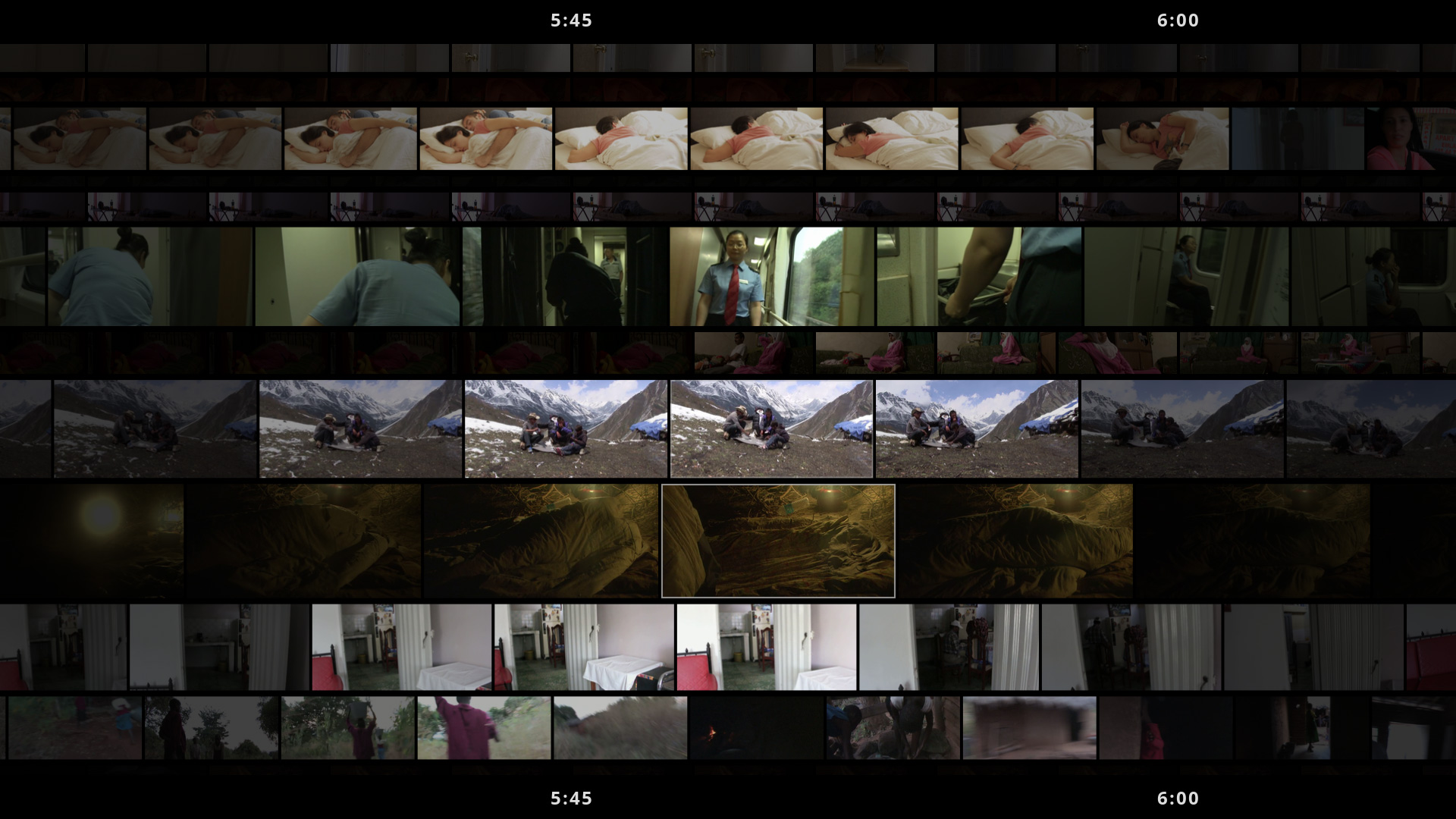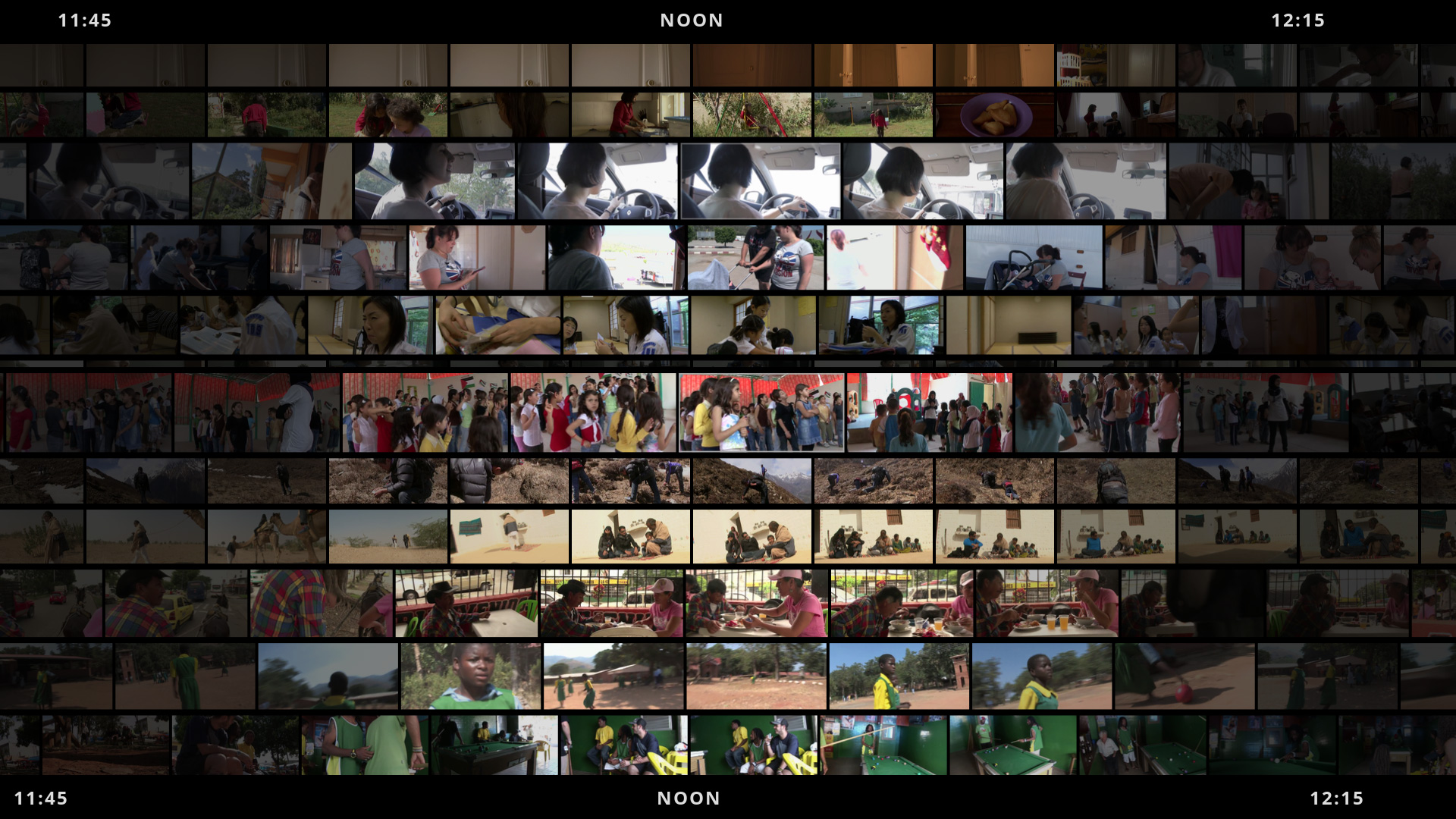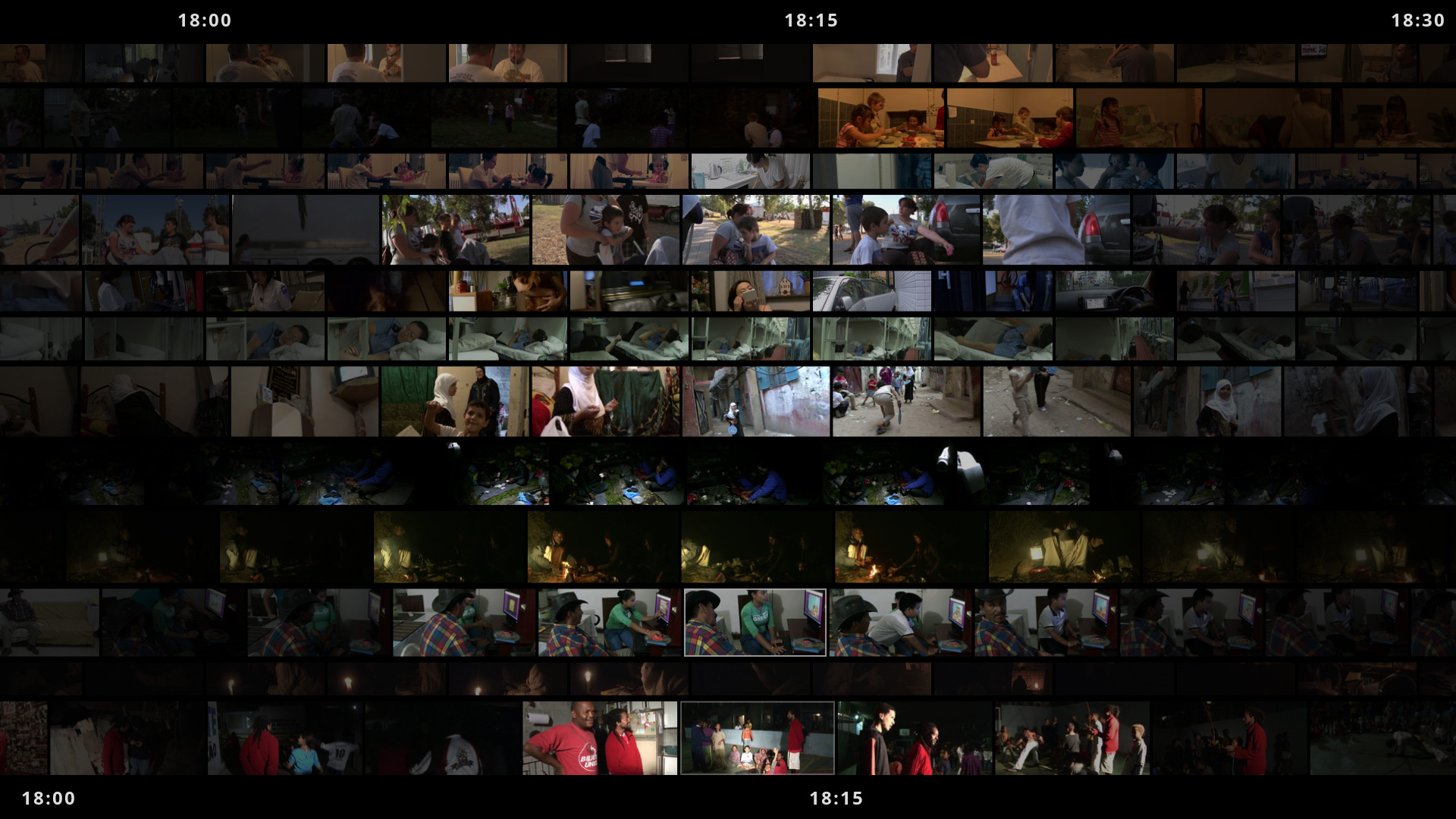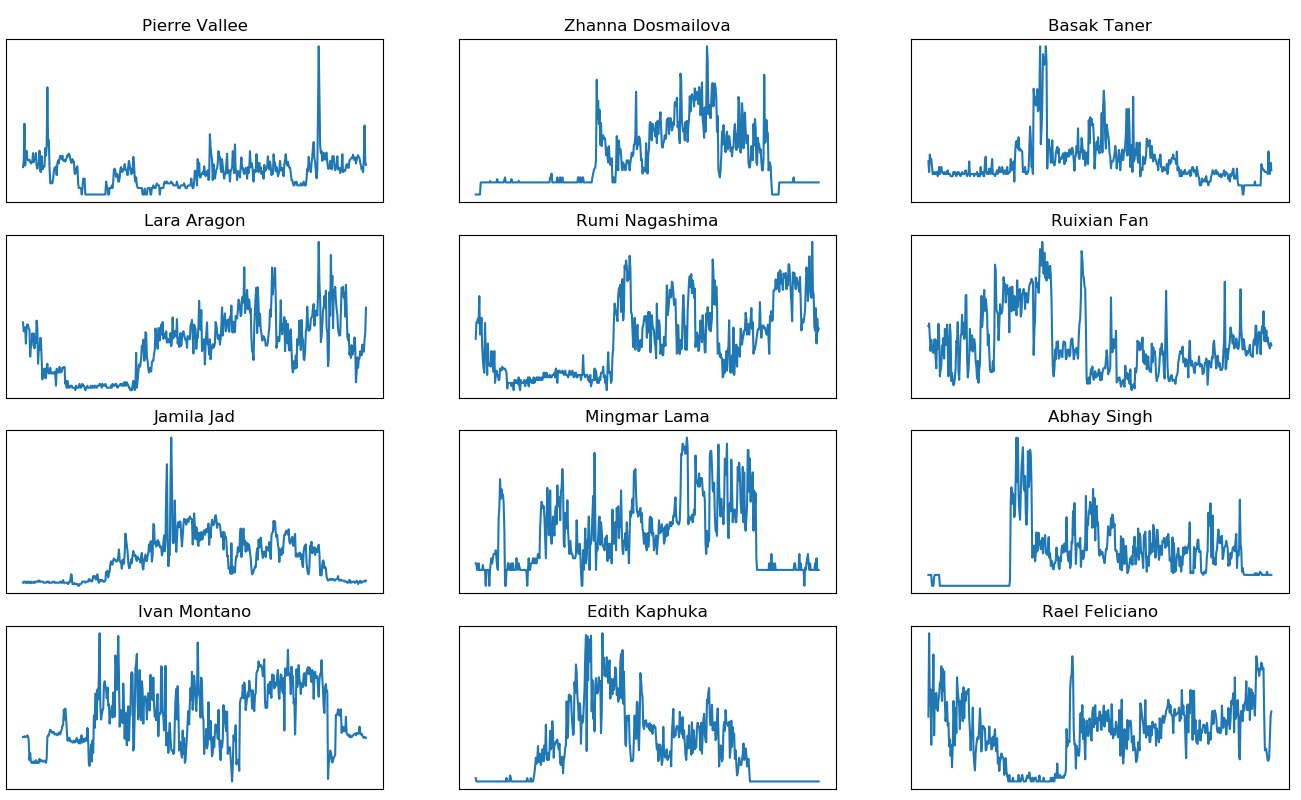12 x 24
12 x 24 (“Twelve by twenty-four”) immerses you in the lives of 12 people from 12 different countries over the course of 24 continuous hours. This film automatically aligns and juxtaposes raw footage from the Global Lives Project, an open video library that documents a complete day in the lives of individuals from around the world. Like the Global Lives Project, this film is a patchwork of daily routines, life experiences, and geographies designed to cultivate empathy across cultures. The film itself, like its source material, is licensed under a Creative Commons BY-NC-SA license, and the custom software that generated the film is open source.
The Film
There is a short version and a long version of this film. This is the short version (20 minutes):
And a long version (60 minutes):
Here are some film stills at approximately 6am, noon, and 6pm:
How is this film constructed?
No part of the film was manually edited. This film is generated completely from code that I wrote which is open source. All the materials that I used are licensed under a Creative Commons license. I hope the process for creating this film can provide value to the film community and beyond:
1. Selecting the material
The Global Lives Project provides access to 24-hour footage of 18 individuals from around the world. I selected 12 individuals that reflected a diversity of ages, professions, and geographic locations. Listed below, sorted by latitude:
| Name | Location | Demographic | Profession |
|---|---|---|---|
| Pierre Vallee | Trois-Rivières, Canada | adult, male | boat pilot |
| Zhanna Dosmailova | Vannovka, Kazakhstan | child, female | none |
| Basak Taner | Istanbul, Turkey | adult, female | pharmaceutical delivery person |
| Lara Aragon | Magaluf, Spain | adult, female | traveling clown |
| Rumi Nagashima | Tokyo, Japan | adult, female | college student, girl scout troop leader |
| Ruixian Fan | Xi’an, China | adult, female | long distance train attendant |
| Jamila Jad | Beirut, Lebanon | child, female | elementary school student |
| Mingmar Lama | Tsum Valley, Nepal | adult, male | farmer |
| Abhay Singh | Barna, India | older adult, male | camel safari guide |
| Ivan Montano | Cali, Colombia | adult, male | horse-cart driver, tailor |
| Edith Kaphuka | Ngwale Village, Malawi | young adult, female | student |
| Rael Feliciano | São Paulo, Brazil | adult, male | hip-hop singer, city permit inspector |
2. Retrieving the material
All films were automatically downloaded from the Internet Archive. Each individual had about 24 hours of footage, broken into 15 to 30 minute intervals. You can view the technical details of this in my code documentation.
3. Analyzing the material
Each individual’s 24 hour footage was broken up into 3-minute intervals. This was somewhat arbitrary, but primarily decided based on the approximate target film duration I wanted (about one hour) and approximately how fast I wanted the footage to move across the screen (1 pixel per frame, at 24 frames per second). Due to my automated process, I can generate different versions of this film at different intervals and durations (up to a 24-hour film!)
Then each 3-minute interval’s audio was analyzed and was assigned a normalized “loudness” value (relative to the rest of the individual’s footage audio loudness). From this you can get the general “shape” of an individual’s day:
This analysis was used to determine which videos to highlight at any given time. In this way, the loudest parts of an individual’s day will be displayed and played more prominently. For example, if a particular individual is awake (and making noise) when others are not, that individual’s video will be shown most prominently. Here’s a visualization of the 12 individual’s relative audio levels (starting at midnight):
As you can see there are a couple individuals that are prominent in the beginning because they are awake while most of the other people are sleeping. During the afternoon and evening, all the individuals are more equally loud, so there is no dominant individual or individuals.
4. Visualizing the material
The film’s visuals are organized as follows:
- Each of the 12 individuals are given a single row. The rows are ordered by latitude, where the first row is the most northern latitude.
- The 3-minute intervals for each individuals’ days are laid out horizontally in columns over a 24-hour period.
Here is a visual of video stills at 5-minute intervals:

- The film slowly moves through the day, where you are seeing a window of about 30 minutes of time at any given moment. On average you are moving through about 24 seconds of “real time” per second of “film time”, thus seeing the full 24 hours in about an hour.
- Each video cell that represents a 3-minute interval grows and shrinks depending on its relative loudness (relative to the loudness of the other parts of the day as well as other individuals’ days). Below is a still from the video at about 2:30 in the morning. As you can see there are three individuals awake (the boat pilot, the train attendant, and the hip hop artist)
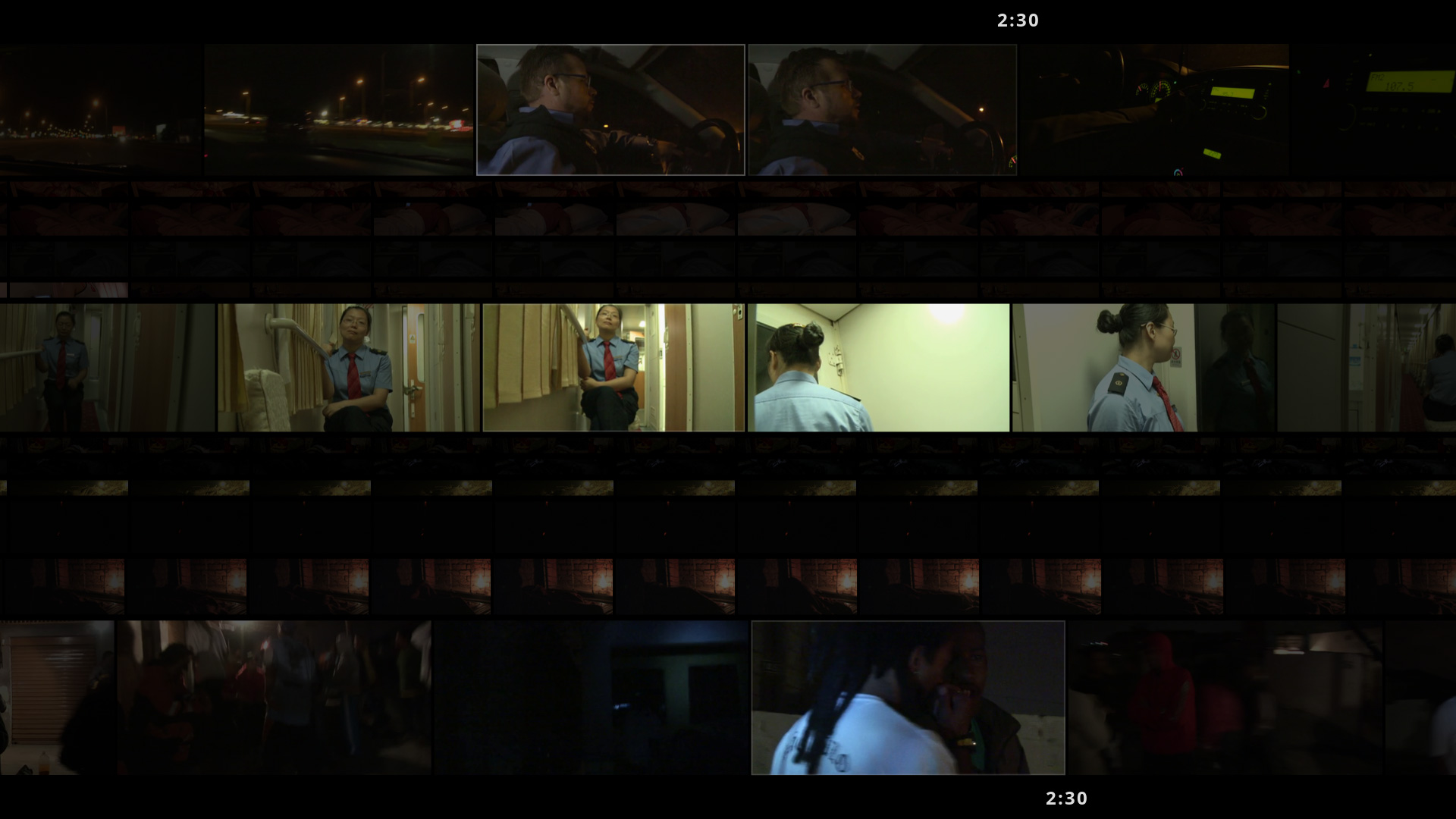
As for the audio, to not be too overwhelming, I only play the audio tracks of the two most prominent (loudest) individuals at any given time. Also, the most prominent individual’s audio will be playing twice as loud as the second one. Here is a visualization of the resulting audio sequence:
Why did you make this film?
This film is part of (and a result of) a long series of personal and professional investigations into visualizing public media archives and collections. Given the overwhelming size of many moving image collections, my approach for visualization is typically involves complete immersion in the patterns and textures of the source materials’ sounds and images.
The Global Lives collection struck me as particularly compelling and unique for a number of reasons. First, there are not many contemporary media collections of this size licensed under a permissive license; in this case, a Creative Commons license. Most public media collections that are in the public domain are very old or are governmental works.
Second, the process by which the films were recorded is transparent, well-defined, and consistent: record an individual for 24 continuous hours in a day from midnight to midnight the next day. This enabled me to apply my own creative processes for visualizing this collection and automatically align and juxtapose the films in compelling and serendipitous ways.
Lastly, the diverse ages, cultures, geographies, and daily routines represented in the films enables an experience that cultivate empathy across time, space, and cultures. The juxtaposition of these individuals daily lives create an immersive collage of daily rhythms, voices, music, and ambience.
